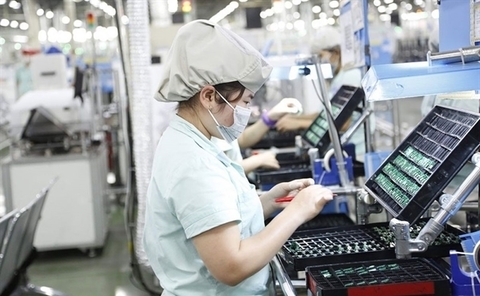
Foreign direct investment (FDI) pledged to Viet Nam surpassed US$38 billion this year, marking a 10-year high and representing a year-on-year increase of 7.2 per cent.— Photo nhipcaudautu.vn
Foreign direct investment (FDI) pledged to Viet Nam surpassed US$38 billion this year, marking a 10-year high and representing a year-on-year increase of 7.2 per cent.
The disbursement of FDI capital also saw a yearly increase of 7 per cent to $20.38 billion, the Foreign Investment Agency (FIA) under the Ministry of Planning and Investment said in its latest report.
According to the FIA, these was encouraging figures in the context of the general downturn of global FDI inflows.
More than 3,880 new projects received investment licences during the year, up 27.5 per cent from 2018, bringing in $16.75 billion in new capital, equivalent to 93.2 per cent of last year.
Meanwhile, 1,380 projects were allowed to raise capital by $5.8 billion, up 18.1 per cent in terms of the number of projects but down 24 per cent in value compared to the same period last year.
A surge of 56.4 per cent was seen in capital contributions and share purchases by foreign investors, raising the amount to $15.47 billion and accounting for nearly 41 per cent of the nation’s total FDI.
According to the report, 65 per cent of this capital, or $24.56 billion, was directed into the processing and manufacturing sector, while 10 per cent, or $3.88 billion, went into the real estate sector and the remainder into wholesale and retail and science and technology.
Among the 125 countries and territories investing in Viet Nam during the year, South Korea remained Viet Nam’s leading source of FDI with $7.92 billion, accounting for 21 per cent of the total.
Hong Kong came next with $7.87 billion, mainly contributed by $3.85 billion spent on shares in the Vietnam Beverage Ltd Co in Ha Noi. Singapore ranked third with $4.5 billion, followed by Japan and China.
Notably, investment from Hong Kong and mainland China had been on an uptrend, mainly thanks to the impacts of US-China trade war. FDI from China increased 1.65-fold and from Hong Kong 2.4-fold year-on-year.
The capital city attracted the largest share of capital commitments with $8.45 billion, making up 22.2 per cent of the total. HCM City came second with $8.3 billion or 21.8 per cent, followed by the southern provinces of Binh Duong and Dong Nai and the northern province of Bac Ninh.
In 2019, the foreign-invested sector earned $181.35 billion from exports, including crude oil, a year-on-year rise of 4.2 per cent. Excluding crude oil, the sector’s export revenue stood at $179.33 billion, a yearly hike of 4.4 per cent and accounting for 68 per cent of the country’s total export earnings.
During the year, the sector spent nearly $145.5 billion on imports, up 2.5 per cent form 2018 and making up 57.4 per cent of the country’s total spending on imports.
As a result, the sector enjoyed a trade surplus of more than $35.8 billion, compensating for a deficit of $25.9 billion recorded in the domestic sector.
“Multiple multi-billion dollar projects will arrive in Viet Nam in the near future, with many of them under South Korean and Taiwanese firms, who view Viet Nam as a strategic and crucial investment destination,” Do Nhat Hoang, head of the Foreign Investment Department under the Ministry of Planning and Investment, said.
Besides existing large corporations such as Samsung, LG and SK who had set up operations in the country, many South Korean and Taiwanese firms were looking to land in Viet Nam, he said.
Overseas investment
According to the FIA, Vietnamese enterprises pumped nearly $510 million into overseas markets in 2019.
Of the investments, more than $400 million was poured into 164 new projects while the remaining $105 million was pledged to 29 existing projects.
Their outbound investment mainly focused on the wholesale and retail sector at $111 million, accounting for 24 per cent of the total.
The agro-forestry-fisheries sector took second place with total investment of $86 million, making up 17 per cent, followed by science and technology at $70 million, accounting for 14 per cent.
Vietnamese firms invested into 32 countries and territories during the year. Australia lured the biggest amount of investment with $155 million, or 31 per cent of the total.
The US came next with $93 million, or 18 per cent, followed by Spain, Cambodia, Singapore and Canada. — VNS